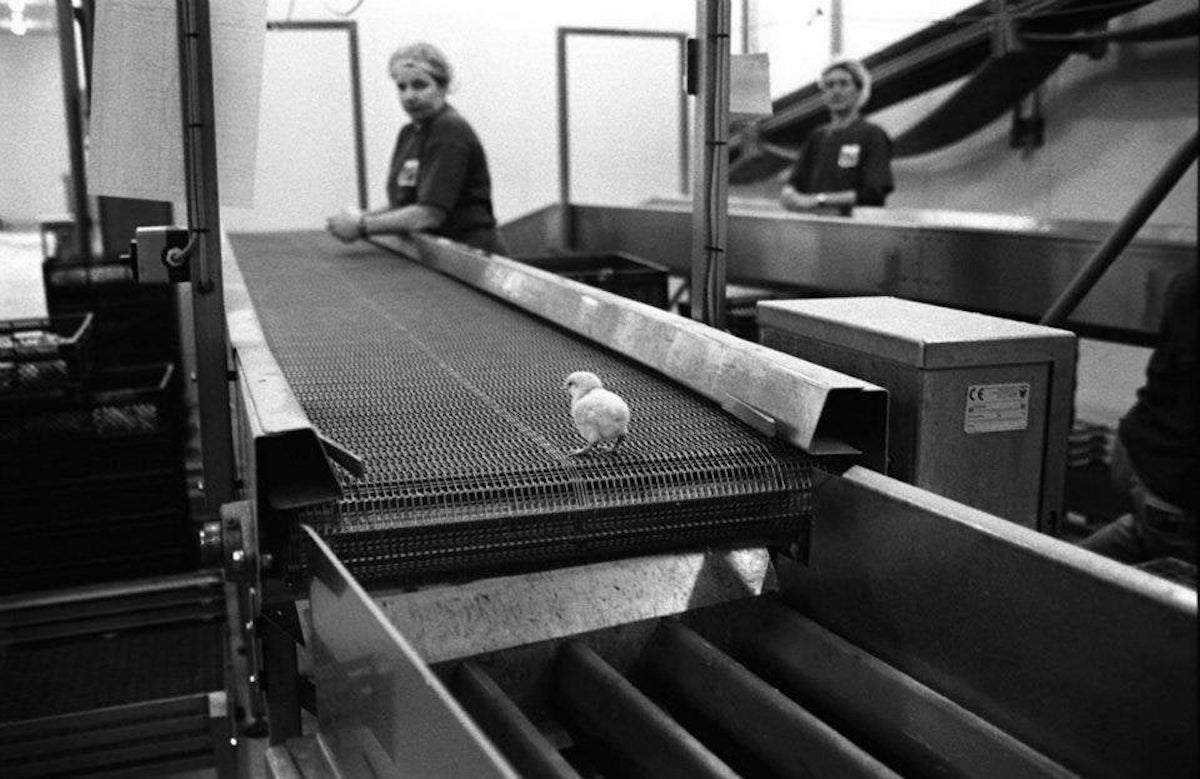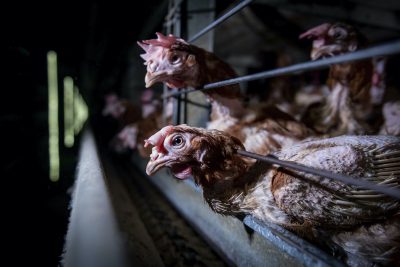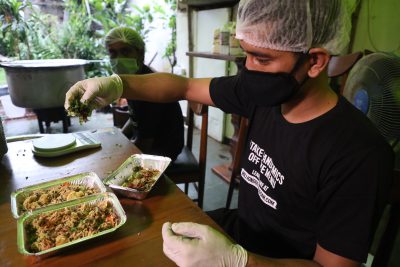If we think about eggs at all, we probably think no more than that they are a convenient foodstuff that comes from the store, but we invite you to go a little deeper, see beyond the packaged product stacked high on a shelf, and consider instead the lives of animals stacked high inside cages on factory farms.
If we do look objectively at this industry, taking care not to get fooled by the egg marketers’ sleight of hand, we will see what is actually pretty obvious: that eggs are, in fact, the reproductive material of female animals who are exploited and abused on an industrial scale.
What Is An Egg Farm?
Modern egg farms keep tens of thousands of female birds – usually chickens – incarcerated in order to efficiently harvest the eggs that they lay. Efficiency is everything because farming is a business and every cent spent is tightly controlled. Within this financial balancing act of expenditure versus profit, the wellbeing of billions of birds, and what makes life worthwhile to them, is simply not factored in.
While there are some organic and cage-free farms in the United States, almost all egg farms are intensive, and the vast majority of hens – 95 per cent of them – live their lives inside a cage. They do not see the sun, breathe fresh air, or scratch in the earth. They do not forage, nest, or dust-bathe.
The cages – made of wire mesh which can cut into the birds’ feet – are stacked high, one on top of another. The birds on the bottom tier are routinely showered in excrement and urine. Not only is their freedom denied them, and not only is suffering an integral part of their daily lives, but all dignity is gone, too. The day they are freed from the cages is the day they die.
The Egg Production Process
The industry breeds birds specifically for their high egg yield. But for every female bird hatched and destined for a lifetime inside a cage, a male bird also hatches.
Like male dairy calves, these chicks are no more than an unwanted by-product. Male birds can’t lay eggs and they are the wrong breed to put on muscle for meat, and farmers simply won’t waste the feed on them. And so on their very first day of life, these beautiful chicks – fluffy and yellow like those on an Easter card – find themselves on an industrial conveyor belt heading for the macerator – a terrifying machine that grinds them up while they are still alive and fully conscious.
Globally, the egg industry kills around 6 billion ‘waste’ male chicks each year, more than 10 times the number of sheep slaughtered. And this mammoth death toll in the egg trade does not factor in the billions of ‘spent hens’ who – exhausted and broken – no longer produce the huge number of eggs demanded of them. Egg-laying hens are typically just 18 months old when they are trucked to slaughter and a new batch of birds is forced into those cages.
Those who think animals do not die in the egg industry couldn’t be more wrong.
Why Are Eggs Not Good For You?
It’s clear that eggs are not good for hens, nor are they good for those day-old male chicks, and they’re not that good for us either.
The extent to which dietary cholesterol affects blood cholesterol remains contested, but recent studies have shown that slim and healthy people in particular are more likely to see an increase in LDL cholesterol (“bad cholesterol”) after eating eggs. Those who eat eggs for health reasons should take note.
In 2019, researchers published a 17-year study of 30,000 adults which showed that each half egg eaten per day led to a 6 per cent increased risk of heart disease and an 8 per cent increased risk of mortality.
Yes, eggs contain some useful nutrients – like choline and lutein – but both of these, as well as every other nutrient the body needs, can be found in plants, so why would anyone take the risk?

Facts The Egg Industry Doesn’t Want You To Know
Male Chicks Are Killed In All Types Of Egg Farming
That billions of tiny male chicks get shredded, crushed or gassed to death is almost certainly the industry’s biggest secret. But don’t be fooled into thinking this happens only in the intensive sector. Being cage-free, free-range, or organic does not save those day-old birds from the macerator.
Birds Are Routinely Starved
Some companies in the United States practice “forced molting”, which more accurately should be called “deliberate starvation”. After starving birds for up to three weeks, the hens lay larger, more profitable eggs once feeding resumes. Unsurprisingly, starving the birds causes extreme suffering. They are so desperate for sustenance that they eat their own feathers, and can behave aggressively towards others during this period. The practice is so clearly cruel that it has been banned throughout Europe.
“Mother Hens” Never Get To Be Mothers
Hens lay eggs to rear chicks, not for people to have something to dip their toast into. And we all know that hens make excellent mothers. After all, we use the phrase “mother hen” to describe someone who is naturally caring and protective. Hens have an instinct to nest, to lay eggs in privacy, and to sit on them, keeping them safe until they hatch. They even communicate with their unhatched chick through the wall of the shell. In the cages, however, they have no choice but to watch every single egg they lay – and every potential chick they might rear – roll away from them down a chute.
More Eggs = Broken Bones
Hens kept for commercial purposes have been selectively bred to lay the largest number of eggs, because that is how the most money is made. But each eggshell requires a lot of calcium, and hens do not get enough in their diets, so their bodies use up the supplies in their bones. As a result, osteoporosis and broken bones are commonplace, with one third of all birds suffering at least one fracture and that is before they are caught and rammed into crates to be sent to slaughter. Just imagine standing on a wire mesh floor day after day on broken legs. This is the price hens pay for our eggs.
Hens Are Deliberately Mutilated
Living in a crowded cage without room to move or stretch their wings, and unable to nest, roost, or lay eggs in privacy causes the birds huge amounts of stress. Unsurprisingly, they take their frustrations out on one another, just as we would if we were packed into a Fiat 500 with four friends for the rest of our lives. Those stressed birds peck at each other which can cause injuries. When those injuries lead to fewer eggs being laid, the industry acts, but instead of giving the birds more space, a better life, and less reason to be frustrated and stressed, they mutilate them. It is standard practice for egg-laying hens to have the ends of their beaks cut off using a hot blade – a process that can cause both acute and chronic pain due to tissue damage and nerve injury.

Evolution Of U.S. Egg Farming
In just 100 years, we have gone from picking up eggs laid by our own free-roaming hens to buying them in a carton from a store, and averting our gaze whenever images of cages, mutilations, bone fractures and macerating chicks come up.
One hundred years ago, almost half of Americans lived on farms, so keeping hens and eating their eggs seemed like a natural thing to do. This started to change in the 1930s as larger flocks were kept and eggs sold as a more commercial enterprise.
In the 1940s – and partially in response to global food shortages during the second world war – all eyes turned to productivity. Why waste your time looking for eggs when you can keep birds in a cage and let the eggs roll down to you? Caging birds did not affect their productivity. After all, hens don’t need to be happy to lay eggs any more than people need to be happy to ovulate. So, while their welfare suffered badly, egg production rose in response to better nutrition and the fact that they were now kept away from pathogens and predators in the outside world. The industry liked this and has been caging birds ever since.
By the 1960s, everyone was doing it. Food production and science combined to eke out every last bit of productivity from the birds, no matter the cost to them individually. Feed was analysed (“how little could they be fed and still lay eggs?”). Lighting was analysed (“how can we trick them into laying more eggs?”). And the highest-yielding strains were bred and bred so that eggs laid per bird increased and increased. The industry was booming!
But there was a bug in the system. Actually, there were a lot of bugs in the system, including Salmonella enterica. By 1985, the number of infections and deaths among those who eat eggs had grown enough for the CDC to start collating information about this particular strain, and between 1985 and 2003, 75 percent of outbreaks were connected to eating eggs.
Despite the deaths of Americans, and despite the cost to the birds, egg farming continued to intensify because farming is a business and the bottom line is king. In the 1980s, hens typically laid 250 eggs a year, which is 25 times the number they would lay naturally. Today, through selective breeding, artificial lighting, and some ruthless decision-making, hens lay almost 300 a year. It’s a trade-off. We get more eggs; the birds suffer more broken bones.
More recently, consumers have started to rebel against the most visible cause of suffering in the egg industry – the cages – but most people still know little of the other hidden cruelties. And while some farms have switched to cage-free and organic farming in response to that demand, there is still a long way to go before no sentient being is caged, starved and shredded on our behalf.
We can be better than this. We can choose compassion.



